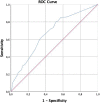Prospective Study in 355 Patients With Suspected COVID-19 Infection: Value of Cough, Subjective Hyposmia, and Hypogeusia
- PMID: 32686164
- PMCID: PMC7404620
- DOI: 10.1002/lary.28999
Prospective Study in 355 Patients With Suspected COVID-19 Infection: Value of Cough, Subjective Hyposmia, and Hypogeusia
Abstract
Objective: To evaluate the incidence of certain symptoms in a population of health workers exposed to coronavirus disease 2019 patients.
Study design: Case-control study.
Methods: The study was conducted at a tertiary care hospital from March 1 to April 7, 2020. Health workers with suspected coronavirus disease 2019 (COVID-19) infection were included. The presence of COVID-19 was detected by using real-time polymerase chain reaction (RT-PCR) methods. Positive and negative RT-PCR patients were used as case and control groups, respectively. This study analyzed the incidence of COVID-19 symptoms in both patient groups. Visual analog scales were used for self-assessment of smell and taste disorders, ranging from 0 (no perception) to 10 (excellent perception).
Results: There were 215 (60.6%) patients with positive RT-PCR and 140 (39.4%) patients with negative RT-PCR. The presence of symptoms such as hyposmia hypogeusia, dysthermia, and cough were strongly associated with a positive RT-PCR. The association of cough and subjective hyposmia had 5.46 times higher odds of having a positive test. The receiver operating characteristic (ROC) analysis showed that a fever higher than 37.45°C resulted in sensitivity and specificity of 0.65 and 0.61, respectively. A total of 138 cases (64.1%) and 114 cases (53%) had subjective hyposmia and hypogeusia, respectively. The 85.4% of these patients recovered olfactory function within the first 14 days of the onset of the symptoms.
Conclusion: There is a significant association between positive RT-PCR and subjective hyposmia. The association of subjective hyposmia and cough increase significantly the odds of having a positive RT-PCR. The measurement of fever as the only method for screening of COVID-19 infection resulted in a poor association.
Level of evidence: 3 Laryngoscope, 130:2674-2679, 2020.
Keywords: Hyposmia, hypogeusia, COVID-19, odds ratio, incidence, ROC.
© 2020 American Laryngological, Rhinological and Otological Society Inc, The Triological Society and American Laryngological Association (ALA).
Figures


Similar articles
-
Prevalence of hyposmia and hypogeusia in 390 COVID-19 hospitalized patients and outpatients: a cross-sectional study.Eur J Clin Microbiol Infect Dis. 2021 Apr;40(4):691-697. doi: 10.1007/s10096-020-04056-7. Epub 2020 Oct 8. Eur J Clin Microbiol Infect Dis. 2021. PMID: 33033955 Free PMC article.
-
Anosmia, ageusia, and other COVID-19-like symptoms in association with a positive SARS-CoV-2 test, across six national digital surveillance platforms: an observational study.Lancet Digit Health. 2021 Sep;3(9):e577-e586. doi: 10.1016/S2589-7500(21)00115-1. Epub 2021 Jul 22. Lancet Digit Health. 2021. PMID: 34305035 Free PMC article.
-
Smell and Taste Dysfunction in Pediatric Patients With SARS-CoV-2 Infection.Pediatr Neurol. 2022 Nov;136:28-33. doi: 10.1016/j.pediatrneurol.2022.07.006. Epub 2022 Aug 1. Pediatr Neurol. 2022. PMID: 36084419 Free PMC article.
-
A review of smell and taste dysfunction in COVID-19 patients.Med J Malaysia. 2020 Sep;75(5):574-581. Med J Malaysia. 2020. PMID: 32918429 Review.
-
Importance of SARs-Cov-2 anosmia: From phenomenology to neurobiology.Compr Psychiatry. 2020 Jul;100:152184. doi: 10.1016/j.comppsych.2020.152184. Epub 2020 May 11. Compr Psychiatry. 2020. PMID: 32422426 Free PMC article. Review.
Cited by
-
Clinical characteristics of patients with confirmed and suspected COVID-19.Am J Transl Res. 2021 Nov 15;13(11):12897-12904. eCollection 2021. Am J Transl Res. 2021. PMID: 34956505 Free PMC article.
-
Olfactory recovery following infection with COVID-19: A systematic review.PLoS One. 2021 Nov 9;16(11):e0259321. doi: 10.1371/journal.pone.0259321. eCollection 2021. PLoS One. 2021. PMID: 34752471 Free PMC article.
-
Prevalence of Olfactory Dysfunction in Coronavirus Disease 2019 (COVID-19): A Meta-analysis of 27,492 Patients.Laryngoscope. 2021 Apr;131(4):865-878. doi: 10.1002/lary.29286. Epub 2020 Dec 5. Laryngoscope. 2021. PMID: 33219539 Free PMC article.
-
Using SCENTinel® to predict SARS-CoV-2 infection: insights from a community sample during dominance of Delta and Omicron variants.Front Public Health. 2024 Apr 10;12:1322797. doi: 10.3389/fpubh.2024.1322797. eCollection 2024. Front Public Health. 2024. PMID: 38660364 Free PMC article.
-
The coronavirus disease 2019: the prevalence, prognosis, and recovery from olfactory dysfunction (OD).Acta Otolaryngol. 2021 Feb;141(2):171-180. doi: 10.1080/00016489.2020.1836397. Epub 2020 Nov 11. Acta Otolaryngol. 2021. PMID: 33176530 Free PMC article.
References
-
- Sim MR. The COVID‐19 pandemic: major risks to healthcare and other workers on the front line. Occup Environ Med 2020;77:281–282. - PubMed
-
- Rubino S, Kelvin N, Bermejo‐Martin JF, Kelvin D. As COVID‐19 cases, deaths and fatality rates surge in Italy, underlying causes require investigation. J Infect Dev Ctries 2020;14:265–267. - PubMed
MeSH terms
LinkOut - more resources
Full Text Sources
Medical
Research Materials
Miscellaneous

